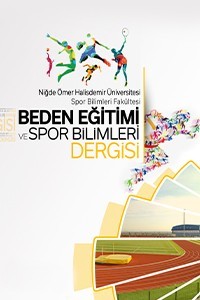ÜNİVERSİTE ÖĞRENCİLERİNDE SAĞLIKLI YAŞAM BİÇİMİ DAVRANIŞLARI İLE FİZİKSEL AKTİVİTE DÜZEYLERİNİN İNCELENMESİ
Sağlıklı Yaşam Biçimi, Fiziksel Aktivite, Öğrenci
ANALYZING THE PHYSICAL ACTIVITY LEVELS AND HEALTHY LIFE STYLE BEHAVIORS OF UNIVERSITY STUDENTS
Healthy Life Style, Physical Activity, Student,
___
- Altun İ., “Kocaeli’nde Yaşayan Halkın Sağlıkla İlgili Tutumlarına ve Sağlık Yaşam Biçimi Davranışlarına İlişkin Bir Çalışma”, Sağlık ve Toplum. 2002, 3: 41-51. [In Turkish].
- Anonimous, “United Nations Population Information” Network. Erişim: (http :// www. un.org/popin/ data. html), 2002, Date accessed: 26.09.2012.
- Ayaz, S., Tezcan, S., Akıncı F. “Health Development Attitudes of Nursing College Students.” Periodical of the Nursing College, Cumhuriyet University, 2005, 9(2), 26- 34. [In Turkish with English Abstract].
- Baltaş Z., Stres ve Sağlık. Sağlık Psikolojisi Halk Sağlığında Davranış Bilimleri. Remzi Kitapevi, İstanbul, 2011.[In Turkish].
- Carr H. “ Physical Activity and Health: The benefits of physical activity on minimising risk of disease and reducing disease morbidity and mortality.” Wellington: Hillary Commission; 2001.
- Caspersen, C.J., Powell, K.E., Christenseon, G.M., “Physical activity, exercise, and physical fitness: Definitions research.” Public Health Rep.: 198 5, 100(2):126-31).
- health related İlke ve Uygulamalar. Nobel Tıp Kitapevleri, 2000, İzmir. [In Turkish].
- Esin N., “ Specification and Development of Industrial Workers' Healthcare Behaviours.” Istanbul University. Publiched Phd. Dissertation,1997, Istanbul. [In Turkish with English Abstract]
- Fişek N. Sağlık Yönetimi. 2 0 0 6, (http://www. /kitap-1/33.html). ttb.org.tr/n-fişek
- 08.2009. [In Turkish]. Erişim tarihi
- Genç ME, Eğri M, Kurçer MA, Kaya M, Pehlivan E, Karaoğlu L, Güneş G. “The Physical Activity Frequencies of Bank Employee in Malatya City Centre.” Inonu University Medical Faculty Periodical. 2002; 9(4): 237-240. [In Turkish with English Abstract].
- Gümüş, H., “Specifiction of the Relation of Health and Body Compositions with the Nutritional and Physical Activity Status of Adolescents who stay in Orphanages” Phd Dissertation, Gazi University, 2009, Ankara. [In Turkish with English Abstract].
- Hallal PC, Victora CG, Wells JC, Lima RC. Physical inactivity: prevalence and associated variables in Brazilian adults. Med Sci Sports Exerc. 2000; 35: 1894-900. 106
- Nigde University Journal of Physical Education And Sport Sciences Vol 7, No 2, 2013
- Niğde Üniversitesi Beden Eğitimi Ve Spor Bilimleri Dergisi Cilt 7, Sayı 2, 2013
- Karadeniz G, Uçum EY, Dedeli Ö, Karaağaç Ö. “ Healthy Living Attitudes of Students”. TSK Protector Doctor Bulletin. 2008, 7 (6): 497-502. [In Turkish with English Abstract].
- Kaya F, Ünüvar R, Bıçak A, Yorgancı E, Çınar B, Öz F, Kankaya FC. “ Examination of healthcare development and affecting agents of instructors”. TSK Protector Doctor Bulletin. 2008, 7 (1): 59-64. [In Turkish with English Abstract].
- Kong, R. “ Building Community Capacıty for Health Promotion: A Challenge for Public Health Nurses”. Public Health Nursing, 1999, 12(5), 312- 318.
- Korkmaz A. “Yükseköğrenim Gençliğinin Problemleri”. Erişim: korkmaz.htm). 2006, Erişim Tarihi : 26. 09.2012. [In Turkish]. /145/
- Özkan S, Yılmaz E., “Healthy living attitudes of nurses employed at hospitals”. Firat Healthcare Periodical. 2008, 3 (7): 90-105. [In Turkish with English Abstract].
- Pasinlioğlu T, Gözüm S. (1998). “ Healthcare attitudes of medical personnel employed at curtail step medical services.” Cumhuriyet University Nursing College Periodical. 2 (2): 1998, 60-68. [In Turkish with English Abstract].
- Phalank, C.,”Determinant of Health Promotive Behavior; a Preview of Current Research. Nursing Clinic North America”, 26(4), 1999, 815- 832.
- Steptoe A,Wardle J, Cui W, Bellisle F, Zotti AM, Baranyai R, Sanderman R. Trends in smoking, diet, physical exercise, and attitudes toward health in European university students from 13 countries, 1990- 2000. Preventive Medicine, 2003, 35: 97-104.
- Şanlı E. The Physical Activity Level- Age, Gender, and Body Mass Index Relation of Teachers. Post Graduate. Ankara: Gazi University; 2008. [In Turkish with English Abstract].
- Ünalan D, Öztop DB, Elmalı F, Öztürk A, Konak D, Pırlak B, Güneş D. “ The relation between eating attitudes and healthy living attitudes of a group of medical college students”. Inönü University Medical Faculty Periodical. 2009, 16 (2) 75-81. [In Turkish with English Abstract].
- Vural, B. K. “Determining Health Risk and its Importance for Nursing”, Cumhuriyet University Nursing College Periodical, 2002, 2(2), 39- 43. [In Turkish with English Abstract]
- Walker SN, Sechrist KR, Pender NJ. “The health- promoting psychometric 1987;36(2):76-81. development Nurs Res.
- Zorba E, İkizler H. C, Tekin A, Miçooğullar, O. Herkes için spor, Morpa Kültür Yayınları, İstanbul, S:125, 2006.[In Turkish]. 107
- ISSN: 1307-6477
- Yayın Aralığı: Yılda 3 Sayı
- Başlangıç: 2007
- Yayıncı: Niğde Ömer Halisdemir Üniversitesi
Fatih MURATHAN, Talha MURATHAN, Ümit YETİŞ, Zait Burak AKTUĞ, Aykut DÜNDAR
SPDORCULAR İÇİN ÖRGÜTSEL STRES DÜZEYİ BELİRLEME ÖLÇEĞİ
Hanifi ÜZÜM, Nevzat MİRZEOĞLU, Ercan POLAT, Selcuk AKPINAR
OLİMPİK, MAKARALI VE GELENEKSEL TÜRK OKÇULUĞU DENGE YETENEKLERİNİN KARŞILAŞTIRILMASI: ÖN ÇALIŞMA
